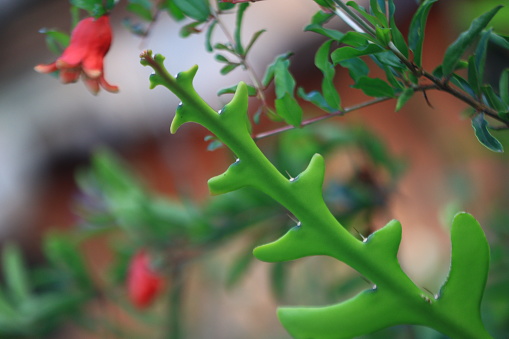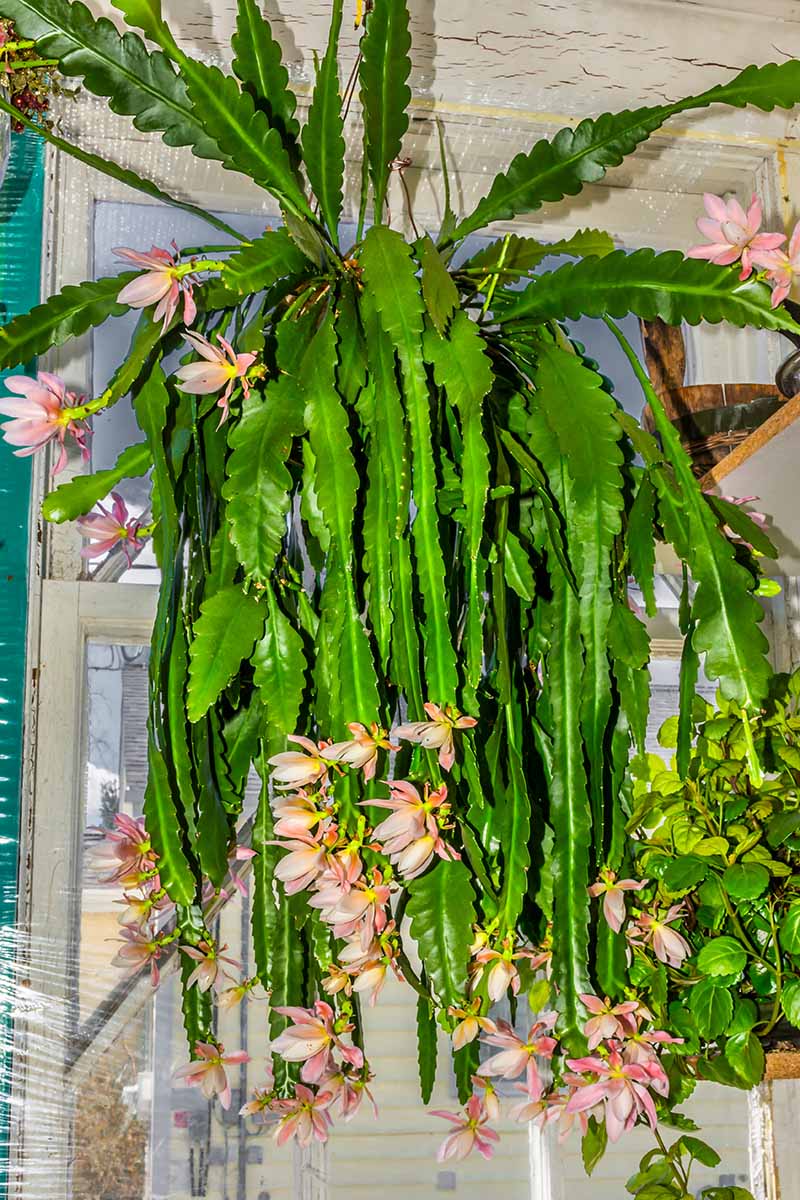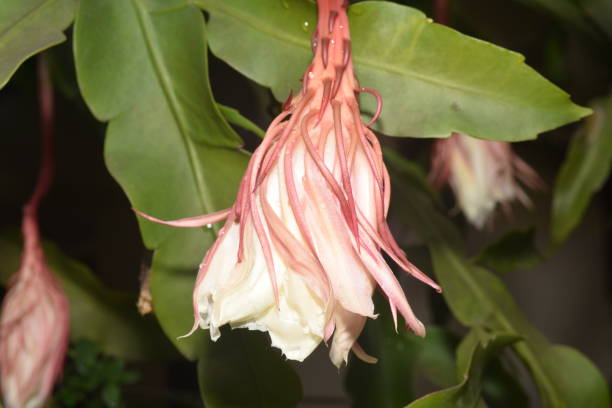Fishbone Cactus Care Guide
Hey folks! Welcome back! We are here with another informative guide that will help you in your gardening field. Have you ever thought of growing a Fishbone cactus in your home garden or might have grown it in your area? Then it’s great, as it is one of the famous plants that is everyone’s favorite choice. The Fishbone Cactus (Epiphyllum anguliger) is a beautiful and strange-looking plant that originates from Central America.
Quick takeaways:
- It gets its name from its zig-zag pattern of stems that resemble the bones of a fish.
- This cactus is not your typical desert cactus; it prefers humid conditions and does not like direct sunlight.
- It is an epiphytic cactus, which means it grows on other plants or trees instead of in the ground.
- Fishbone Cactus will thrive well if you will maintain their growth. So, it is important to care for your plant so that you get that desired results from it.
If you’re thinking about adding a Fishbone Cactus to your collection, read on for a care guide on how to best take care of this unique plant! So, let’s get started to know about the Fishbone Cactus Care guide in detail so that you maintain the growth of your plant properly. You just need to stay connected with the guide.

Fishbone Cactus Care
As mentioned maintaining the plants is very essential to do. For long-lasting results, it is important to know about the Fishbone Cactus Care tips like the Ric Rac Cactus that are explained below:
Sunlight needs
One of the things for maintaining the growth of Fishbone Cactus is their sunlight needs. When it comes to Fishbone Cactus care, the most important thing to keep in mind is that this plant needs a lot of light like bamboo.
Too much shade will cause the stems to stretch out and become weak. The ideal location for your Fishbone Cactus is in a bright spot where it will get plenty of direct sunlight.
Humidity needs
Humidity is the other factor that needs to keep in mind at the time of Fishbone Cactus Care. If you live in an area with low humidity, your Fishbone Cactus may benefit from being misted with water every now and then.
Just make sure not to do this too often, as too much moisture can encourage fungal growth in the plant.
Soil requirements
In addition to lots of light, Fishbone Cacti also need well-drained soil. They are susceptible to root rot, so it’s important to make sure their roots don’t stay wet for too long. Soil is another factor that needs to keep in mind at the time of Fishbone Cactus Care.
The best way to achieve this is by using a cactus mix or adding some sand to your potting soil.
Watering needs
Watering your Fishbone Cactus should be done sparingly, only when the soil is completely dry. Water is a vital source that is needed by every plant to attain growth. Water is the other factor that needs to keep in mind at the time of Fishbone Cactus Care.
When you do water, make sure to give the plant a good soaking so that the water reaches the roots. Be careful not to overdo it though, as too much water can also lead to root rot. Water fishbone cacti deeply but infrequently, about every 2-3 weeks during the growing season and even less often in winter.
Pro tip:
During the spring and summer months, your Fishbone Cactus will likely bloom if it’s getting enough light. The flowers are small and white, but they are quite pretty nonetheless. If you want to encourage blooming, you need to maintain your plant.

Propagating the Fishbone Cactus
To propagate your Fishbone Cactus, you will need to take a cutting from a healthy, mature plant. Below are the steps to propagate the Fishbone Cactus:
Step 1– First, you have to Cut a stem that is at least 3-4 inches long, and make sure that there are 2-3 nodes (the swollen areas where leaves attach to the stem) on the cutting. You can use a sharp knife or shears for this.
Step 2– Next, allow the cutting to callous over for a few days by letting it sit out in the open air. This will help to prevent rotting when you plant the cutting.
Step 3– Once the cutting has been calloused, fill a small pot with a well-draining cactus or succulent potting mix.
Step 4– Plant the cutting in the mix, making sure that the nodes are buried.
Step 5– Water lightly, and then place the pot in a bright spot but out of direct sunlight.
Your Fishbone Cactus should start to grow roots within 2-4 weeks. Once it has rooted, you can begin watering it more regularly (about once per week), and eventually, transfer it to a larger pot if necessary. Enjoy your new plant!
Related: Overwatered Cactus (Signs, Causes, And Solutions)
Common Pests & Plant Diseases
Many people who grow cacti and succulents as houseplants are familiar with the two most common pests: mealybugs and scale. Both of these pests look like small bumps on the plant and can be difficult to get rid of. However, there are a few things you can do to control them.
Mealybugs are small, white insects that feed on the sap of plants. They can cause damage to the plant by sucking out the nutrients it needs to grow. Mealybugs can also spread diseases from one plant to another.
Scale is similar to mealybugs, but they are usually darker in color and have a hard shell. Scale insects feed on the sap of plants and can weaken and even kill the plant if they are not controlled.
There are a few different ways to control these pests. You can use insecticidal soap, which is safe for humans and pets but will kill any insects it comes in contact with. You can also use neem oil, which is a natural pesticide that is effective against many different types of pests. Whatever method you choose, make sure to follow the instructions carefully so that you do not harm your plants.
In addition to pests, Fishbone cactus can also be susceptible to a few different diseases. The most common disease is root rot, which is caused by too much water around the roots of the plant which may lead to turning whiting or turning brown. This can lead to fungal growth and eventually kill the plant.

How to Get a Fishbone Cactus to Bloom?
Before we get into how to make your fishbone cactus bloom, it’s important to know a little bit about the plant itself. The scientific name for this popular cactus is Disocactus hybrids, and it’s part of the family Cactaceae. This means that it shares many characteristics with other cacti, such as being drought-tolerant and requiring bright light.
Now that we’ve got that out of the way, let’s talk about how to get those beautiful flowers! The first step is to make sure that your plant is healthy and happy.
Fishbone cacti are relatively easy to care for, but like all plants, they need the right environment to thrive.
Be sure to give your plant plenty of bright light and well-draining soil. Water when the soil is dry to the touch, and fertilize monthly during the growing season.
If you provide proper care, your fishbone cactus should begin blooming in late spring or early summer. The flowers are typically red or yellow, and they only last for a day or two. But don’t worry – once the flowering begins, you can expect several weeks of blooms!
Common Problems With the Fishbone Cactus
The fishbone cactus is a beautiful and unique plant that can add color and intrigue to any indoor or outdoor space. However, like all plants, the fishbone cactus is not without its problems. Here are some of the most common problems associated with this plant:
1. Overwatering: The fishbone cactus is very sensitive to overwatering and will quickly start to rot if given too much water. When watering your fishbone cactus, be sure to use only distilled or filtered water and allow the soil to dry out completely between watering.
2. Sunburn: The fishbone cactus loves full sun but can be susceptible to sunburn if it gets too much direct sunlight. If you notice your plant starting to turn red or brown, move it to a shadier spot.
3. Pests: The fishbone cactus is especially susceptible to mealybugs and spider mites. These pests can quickly infest a plant and cause damage. Be sure to check your plant regularly for signs of pests and treat them immediately if found.

Wrapping up the Context
In this guide, you come to know that the Fishbone cactus is not your typical desert cactus; it prefers humid conditions and does not like direct sunlight. It is an epiphytic cactus, which means it grows on other plants or trees instead of in the ground. Fishbone Cactus will thrive well if you will maintain their growth. So, it is important to care for your plant so that you get that desired results from it. Read the full guide for its proper understanding.
Thanks for reading! Happy gardening!
FAQ’s
How do I get my fishbone cactus to flower?
To encourage your fishbone cactus to flower, give it a cool winter rest period. Reduce watering but do not underwater the cactus and allow the soil to dry out completely between watering.
Place the cactus in a cool, dark room with a temperature between 50-59 degrees Fahrenheit for at least two months. Resume regular watering and care after the rest period.
Does fishbone cactus like the full sun?
Yes, the fishbone cactus does like full sun. It’s a good idea to give it at least 4 hours of sunlight each day, although it will do fine with less.
The more sun it gets, the more vibrant its colors will be. If you live in an area with very hot summers, you may want to protect your cactus from the midday sun by giving it some afternoon shade.
How often do you water a fishbone cactus?
Assuming you are referring to the plant known as Epiphyllum anguliger, commonly called fishbone cactus or zigzag cactus, here are some tips on watering. As with most cacti, this plant is adapted to survive long periods without water. They will do best if allowed to dry out completely between watering.
Water fishbone cacti deeply but infrequently, about every 2-3 weeks during the growing season and even less often in winter. Be sure to drain any excess water from the saucer after each watering. Overwatering is the most common cause of death for these plants.
Should you cut off a cactus flower?
If your cactus is blooming, you may be wondering if you should cut off the flower. The answer depends on what you want to achieve with your plant. If you are growing your cactus for its flowers, then you will want to leave the bloom on.
However, if you are growing your cactus for its shape or size, then it is fine to remove the flower. Keep in mind that removing the flower will not affect the health of your cactus, but it may prevent future blooming.
Does the fishbone cactus flower?
The answer to this question is a bit complicated. The fishbone cactus (also called the rat-tail cactus) is a member of the cactus family, and like all cacti, it produces flowers. However, the fishbone cactus is a rather unusual-looking plant, and its flowers are not particularly showy. In fact, they are often hidden among the plant’s spines. For this reason, many people assume that the fishbone cactus does not flower.
However, if you take a close look at a fishbone cactus, you may be able to see small buds forming at the tips of its stems. These buds will eventually open up into flowers, but they are often hard to spot. The flowers themselves are small and white or pink in color. They only bloom for a few days before closing back up again.
So does the fishbone cactus flower? Yes, but its flowers are often hidden among its spines and can be hard to spot.


